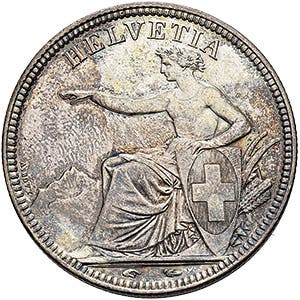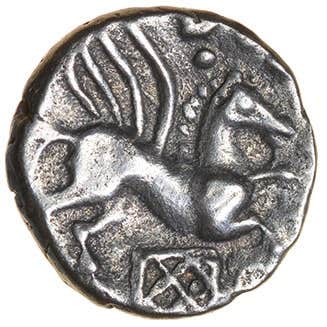Heritage auction brings $9 million
By any measure, Heritage’s World & Ancient Coins Platinum Night sale at the American Numismatic Association World’s Fair of Money on Aug. 17 in Philadelphia was an outstanding success. The…
By any measure, Heritage’s World & Ancient Coins Platinum Night sale at the American Numismatic Association World’s Fair of Money on Aug. 17 in Philadelphia was an outstanding success. The 453 lots up for bids scored a total of $9,600,421.
Twenty achieved six-figure sums; 186 took five figures apiece.
By now, most readers will be aware that the sale total was helped considerably when “The First ‘Dollar’ of the Americas,” the legendary 1538 Carlos and Joanna 8 reales, sold for $528,000.
The coin had gone to the block requiring a starting bid of $250,000 and graded Numismatic Guaranty Corporation AU50.
The price is not quite a world record for the coin, but it is a Heritage record for most expensive Latin American coin the firm has ever sold. When the same coin was first sold by Heritage in 2006, it realized $373,750.
Prior to the First Dollar sale, a group of Roman gold aurei stole the show. Each of these pieces was in stunning condition and came accompanied by a superb pedigree. Two tied for top honors, scoring $336,000 apiece.
First up was an extremely well struck high-relief, 19 mm, 7.22 g aureus of the youthful Emperor Diadumenian produced in Rome in 218 CE (RIC IV, Part II, 115. Calicó 2984a).
It came with an NGC photo-certificate graded Choice AU Star 5/5 - 4/5 and last sold in 2013 for $270,000.
Second was a well-struck fine style, 20 mm, 7.95 g aureus showing Sextus Pompeius as Imperator c. 44-36 B.C.E. (Calicó 71).
As previously, it was accompanied by an NGC photo-certificate Choice AU Star 5/5 – 4/5. It had last fetched $225,345 in 2012.
An extremely rare aureus of Macrinus (Calicó 2947), NGC Choice AU Star 5/5 – 5/5, took $288,000; a sharply struck, well centered aureus of Postumus (RIC V, Part II, 29), NGC MS 5/5 – 3/5, made $264,000; and a choice aureus of Probus (RIC V, Part II, 918), NGC Choice AU Star 5/5 – 5/5, fetched $120,000.
From a somewhat earlier historical period, a mint state (NGC MS Star 5/5 – 5/5) 19 mm, 10.79 g, Lydian gold stater of Croesus c. 561-550 B.C.E., (BMC Lydia 30) had absolutely no problem in finding a new home for $144,000.
Rare high-grade silver ancients were also in demand. Top coin here was a superb 24 mm, 12.29 g Delphian stater from Phocis, c. 338-334 B.C.E. The obverse shows the veiled head of Demeter to left wearing wreath with Apollo seated left on the reverse. Ex Pierpont Morgan Collection, this coin is plated in the “Catalogue of Greek and Roman Coins” (1953) 177. With “splendid deep cabinet toning,” it easily realized a most comfortable $228,000.
Then there was the rest of the world. Highest price here went to a delectable NGC PR61+ Ultra Cameo, Una and the Lion 5 pounds proof of 1839 with lettered edge (KM-742, S-3851). Bidding started at $75,000 and promptly romped away to close at $204,000.
The reign of Queen Victoria featured twice among the top six-figure twenty. An extremely rare and enigmatic 1853 proof set (KM-PS7, S-PS4) in which her 16 coins grade from PR62 to PR66 had no trouble in making $156,000. The set is likely the finest matched and complete of its type extant.
Full details of auction lots sold and prices realized are available online at www.ha.com.
This article was originally printed in World Coin News. >> Subscribe today.
If you like what you've read here, we invite you to visit our online bookstore to learn more about Standard Catalog of World Coins, 1601-1700.









